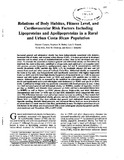| dc.creator | Campos Núñez, Hannia | |
| dc.creator | Bailey, Stephen M. | |
| dc.creator | Gussak, Lisa S. | |
| dc.creator | Siles Díaz, Xinia | |
| dc.creator | Ordovas, José M. | |
| dc.creator | Schaefer, Ernst J. | |
| dc.date.accessioned | 2015-10-22T22:22:25Z | |
| dc.date.available | 2015-10-22T22:22:25Z | |
| dc.date.issued | 1991-07 | |
| dc.identifier.citation | http://atvb.ahajournals.org/content/11/4/1077.full.pdf+html | |
| dc.identifier.issn | 1079-5642 | |
| dc.identifier.issn | 1524-4636 | |
| dc.identifier.uri | https://hdl.handle.net/10669/15293 | |
| dc.description | Artículo científico -- Universidad de Costa Rica, Instituto de Investigaciones en Salud. 1991. La revista no permite distribuir la versión final del PDF. | es_ES |
| dc.description.abstract | Increased general and abdominal obesity has been independently associated with diabetes,
increased risk of stroke, and coronary artery disease (CAD). It is more prevalent in developed
countries and in urban areas of nonindustrialized nations than in less developed and rural
areas. To evaluate the associations between general and abdominal obesity (as determined by
total body fat, waist to hip ratio, umbilical to triceps ratio, and umbilical to subscapular ratio)
with glucose, plasma lipoproteins, apolipoprotein (apo) A-I and B concentrations, and low
density lipoprotein (LDL) particle size (LDL 1-7), we randomly selected 222 men and 243
women from rural and urban areas of Puriscal, Costa Rica. Abdominal obesity, as assessed by
the waist to hip ratio, was independently and significantly associated with higher triglyceride
levels (p <O.01) and with lower high density lipoprotein cholesterol levels (p <0.05) in men and
women and with higher glucose levels ( p <0.05) and smaller LDL particle size (p <0.01) in
women. Abdominal obesity, as assessed by the umbilical to subscapular ratio, was independently
and significantly associated with higher total cholesterol (p <0.005) and apo B (p<0.01)
levels. Umbilical to triceps ratio was positively associated with blood pressure in men. Urban
men had increased general and abdominal obesity (p <0.0001), number of cigarettes smoked
per day (p <0.0001), and diastolic blood pressure (p <0.05) and had a decreased fitness level
(p <0.0001) as well as higher (p <0.05) plasma glucose, triglyceride, and total cholesterol
concentrations and lower (p<0.05) apo A-I and IIDL cholesterol levels compared with rural
men. The differences between rural and urban women were not as striking. Urban women had
increased general and abdominal obesity, glucose, and apo B levels (p<0.05) and a decreased
fitness level (p <0.0001). Our data indicate that general and abdominal obesity, increased
cigarette smoking, diastolic blood pressure, and decreased fitness level are more prevalent in
an urban than in a rural area in Costa Rica, particularly in men. The higher prevalence of such
risk factors in the urban area is associated with a more atherogenic plasma lipoprotein profile. | es_ES |
| dc.description.sponsorship | Universidad de Costa Rica, Instituto de Investigaciones en Salud. | es_ES |
| dc.language.iso | en_US | es_ES |
| dc.source | Arteriosclerosis, Thrombosis, and Vascular Biology 11(4): 1077-1088 | es_ES |
| dc.subject | Costa Rica | es_ES |
| dc.subject | fitness level | es_ES |
| dc.subject | cardiovascular risks | es_ES |
| dc.subject | coronary artery disease (CAD) | es_ES |
| dc.subject | apolipoprotein (apo) | es_ES |
| dc.subject | plasma lipoproteins | es_ES |
| dc.subject | triglycerides | es_ES |
| dc.title | Relations of body habitus, fitness level and cardiovascular risk factors including Lipoproteins and Apolipoproteins in a rural and urban Costa Rican population | es_ES |
| dc.type | artículo original | |
| dc.identifier.doi | 10.1161/01.ATV.11.4.1077 | |
| dc.description.procedence | UCR::Vicerrectoría de Investigación::Unidades de Investigación::Ciencias de la Salud::Instituto de Investigaciones en Salud (INISA) | es_ES |


